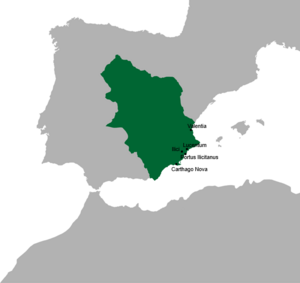Battle of Cartagena (461) facts for kids
Quick facts for kids Battle of Cartagena |
|||||||
|---|---|---|---|---|---|---|---|
| Part of the Germanic Wars | |||||||
 Although the battle took place on the coast of the province Carthaginensis (green), it was not in the provincial capital Cartagena itself, but 40 nautical miles away in Portus Ilicitanus (Santa Pola) |
|||||||
|
|||||||
| Belligerents | |||||||
| Vandals | |||||||
| Strength | |||||||
| unknown | 300 ships | ||||||
| Casualties and losses | |||||||
| Unknown | Unknown | ||||||
The Battle of Cartagena was a naval battle that happened on May 13, 460 AD (or possibly 461 AD). It was part of the wars led by the Roman Emperor Majorian. Even though it's called the "Battle of Cartagena," it didn't actually happen in the city of Cartagena.
Instead, the battle took place on the coast of the Roman province called Hispania Carthaginensis. This area is now near Santa Pola, Spain, in the bay of Alicante. The exact spot was Portus Ilicitanus, which was the port for the city of Elche. Because of this, some people also call it the "Battle of Elche."
The historian Marius Aventicensis wrote about it:
460: Eo anno captae sunt naves a Vandalis ad Elecem juxta Carthaginem Spartariam.
—Marius Aventicensis, Chronica de obispo de Aventicum
What Led to the Battle
In 457 AD, a Roman general named Majorian became the new emperor of the Western Roman Empire. He had a big goal: to make the Roman Empire strong again and get back its lost lands.
Majorian decided to start by building a large fleet of ships. He planned to use these ships to invade the Vandal Kingdom in North Africa. The Vandals were a powerful Germanic group who had taken control of important Roman territories.
He began gathering his ships at Portus Ilicitanus, which was a good port near Elche.
The Battle Unfolds
By the spring of 460 AD (or 461 AD), Emperor Majorian had already built about 300 ships. He was planning to have even more ships ready by the autumn.
The Vandals, led by their king, Genseric, knew about Majorian's plans. They decided to attack before the Roman navy became too strong to defeat.
On May 13, a fleet of Vandal ships launched a surprise attack on the Roman fleet. Sadly, many Roman ship captains had been secretly paid to switch sides and betray their own empire.
The Vandal attack was very successful. The Roman navy was completely destroyed. This defeat meant that Majorian's dream of taking back North Africa from the Vandals was over.
Another historian, Hydatius, described the event:
Mense Maio Majorianus Hispanias ingreditur imperator: quo Carthaginiensem provinciam pertendente, aliquantas naves quas sibi ad transitum adversum Wandalos praeparabat, de littore Carthaginiensi commoniti Wandali per proditores abripiunt. Majorianus ita sua ordinatione frustratus ad Italiam revertitur.
—Hydatius, Chronicon
See also
 In Spanish: Batalla de Cartagena (460) para niños
In Spanish: Batalla de Cartagena (460) para niños

